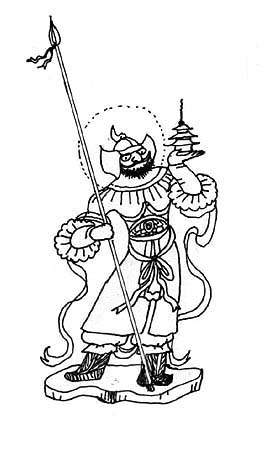|
||
 |
||

(C)2001 Japanese Architecture and Art Net Users System. No reproduction or republication without written permission.
掲載のテキスト・写真・イラストなど、全てのコンテンツの無断複製・転載を禁じます。
|
||||||
| Bishamonten 毘沙門天 | ||||||
| KEY WORD : art history / iconography | ||||||
| A deity called *Tamonten 多聞天 as the member of the *shitennou 四天王 who is guardian of the north, but called Bishamonten as a focus of belief in his own right or as the guardian of the north amongst *juuniten 十二天. He is the Indian deity called Kuvera 倶尾羅, a god of wealth who presides over the northern direction and is chief of the *yasha 夜叉 and *rasetsu 羅刹. One of Kuvera's epithets is Vaisravana. Images of him were made in Japan from the Heian period. He wears armor and usually holds a *houtou 宝塔 in one hand and a sansageki 三叉げき or baton houbou 宝棒, in the other. Bishamonten and Tamonten are identical in iconography, but Bishamonten may be accompanied by *Kichijouten 吉祥天, his wife, and by Zennishi douji 善膩師童子. As a protector of the north, Bishamonten's presence had a clear role in a temple such as Kuramadera 鞍馬寺, which was built to protect the northern areas of Kyoto. He was also a protector of the Buddhist teaching and of the nation. Tales of Bishamon's miraculous power appear in collections, and, as the main image of the temple, he is celebrated in the late Heian, Illustrated Handscroll of the Legends of Mt. Shigi Shigisan engi emaki 信貴山縁起絵巻. From the Muromachi period on, he was popularly known as a deity of good fortune, and once included among the *shichifukujin 七福神 in the Edo period, he was widely revered. Examples of sculptures of Bishamonten include the late Heian sculpture of Kuramadera; the 1078 sculpture in Houryuuji *Kondou 法隆寺金堂; and the 1162 sculpture belonging to the Kawabata 川端 family that was originally made for a hall at Nakagawadera 中川寺 and remarkable for dedicatory materials that include sheets of cloth printed with little pictures of Bishamonten. There are also the 1178 sculpture of a helmetted Bishamonten in Hagaji 羽賀寺 in Fukui prefecture and the set of Bishamonten, Zennishi douji and Kichijouten carved by Tankei 堪慶 (1173-1256) around 1225. In addition, there is a late Heian painting at Uesugi Jinja 上杉神社 in Yamagata prefecture. Bishamonten, like the shitennou usually stands on one or two demons, called *jaki 邪鬼. Among images of Bishamonten, some show him supported by the female deity Jiten 地天 (Sk: Prithvi). Although this iconography does appear in sculpture of Tamonten among the shitennou as in the sculpture in the *Koudou 講堂 of Touji 東寺 (Kyouougokokuji 教王護国寺), an independent form of Bishamonten standing on Jiten is referred to as *Tobatsu Bishamonten 兜跋毘沙門天. Some of the sculptures of Tobatsu Bishamonten in Japan are close copies of sculptures of the Tang dynasty at Touji, said to have been imported into Japan in the early Heian period, reputedly by *Kuukai 空海 (774-835). Tobatsu Bishamonten is said to have been accorded his role due to a story told in Soukousouden 宋高僧伝. In 742, when Tibet (Jp: Toban 吐番) attacked Kizil (Jp: Ansei 安西), the Chinese emperor ordered Fukuu 不空 (Sk; Amoghavajra; the Shingon 真言 patriarch) to pray to Bishamonten. Koumyou Daiou 光明大王 then appeared in the upper story of the north gate of the castle and the enemies were defeated. Consequently, when a sculpture of Bishamon was made in China as a protector of a regal citadel, or capital city, it was this form Koumyou Daiou that was made and called Tobatsu owing to its association with the country Tobatsu, another name for Tibet. However, this story has not been proven. It does explain why the Tang dynasty Bishamonten of Touji was, according to the temple chronicle TOUHOUKI 東宝記, originally placed in the Rajoumon 羅城門 of Kyoto. The Tobatsu Bishamonten in Seiryouji 清涼寺 is a faithful late Heian copy of the Touji sculpture, although less dynamic and carved with less fine decorative detail. A dissimilar image, thought to have been modelled on a sculpture at Mt. Hiei 比叡, is the early Heian sculpture that is almost four meters tall, located in the Narushima Bishamondou 成島毘沙門堂 in Iwate prefecture. | ||||||
 |
||||||
| REFERENCES: | ||||||
| EXTERNAL LINKS: | ||||||
| NOTES: | ||||||
(C)2001 Japanese Architecture and Art Net Users System. No reproduction or republication without written permission. 掲載のテキスト・写真・イラストなど、全てのコンテンツの無断複製・転載を禁じます。 |
||||||